What does the inverted red triangle used by some pro-Palestinian demonstrators symbolize?
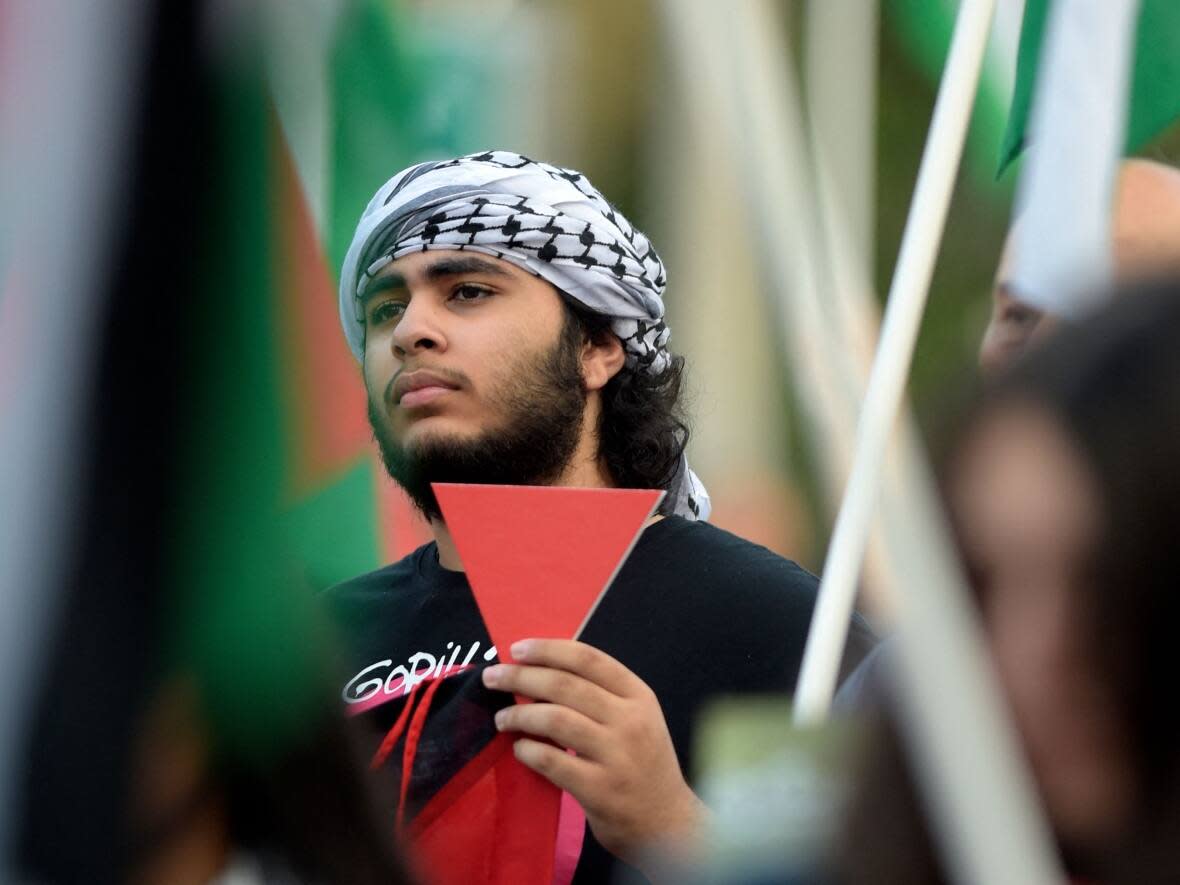
Depending on how it's used or who you ask, it's a target, a symbol of resistance, a piece of history or propaganda.
And the controversial symbol has been seen at pro-Palestinian university encampments across the country calling for divestment from Israel.
The inverted red triangle has been used in videos by the Al-Qassam Brigades, Hamas's military wing, to identify Israeli military targets, such as tanks, in Gaza as Israel began its ground invasion there. A caricature mocking Israeli soldiers included the symbol, as do many pro-Palestinian social media posts.
It's also been spotted on signs and graffiti, and in global protests, where many see it as a symbol of Palestinian resistance, similar to the slingshot. And it harkens to the red triangle in the Palestinian flag, symbolizing Arab unity.
As experts in the Israel-Palestinian conflict point out, the meaning and history of the controversial symbol — which has become synonymous with the protest, much like the watermelon emoji and the keffiyeh — is complex.
"Symbols take meanings and a life of their own," Mayssoun Sukarieh, a senior lecturer in Middle Eastern studies at King's College London, told CBC News.
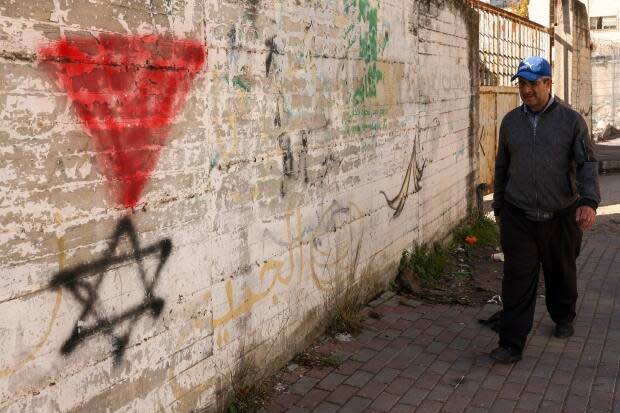
Because the Palestinian solidarity movement is diverse in race, faith and gender, there's no one way to interpret how protesters use the red triangle, said Chandni Desai, an assistant professor at the University of Toronto who researches Palestinian studies.
"Either way you go, it's very contentious," said Costanza Musu, an associate professor at the University of Ottawa who has taught the history of the Israeli-Palestinian conflict for the past 20 years.
"It is so important in this conflict to understand symbols and words. They really matter."
WATCH | U of T president defends measures combating on-campus antisemitism:
Historical significance of the triangle
The inverted red triangle's symbolic origins predate Oct. 7, the day about 1,200 people were killed in the Hamas-led attacks on southern Israel, with about 250 taken hostage, according to Israeli figures. Israel's offensive since the war began has killed more than 35,800 Palestinians, according to Gaza's Health Ministry, and has caused a humanitarian crisis and left its population near famine.
The red triangle appears in the Palestinian flag, where it represents the role the Hashemite dynasty played in the Arab Revolt against the Ottoman Empire during the First World War, Desai said.
"The colour red symbolizes the blood of those who sacrificed in battle for the Arab cause and the Palestinian cause. Red is also one of the Pan-Arab colours, along with black, white and green, which together represent Arab unity and independence."
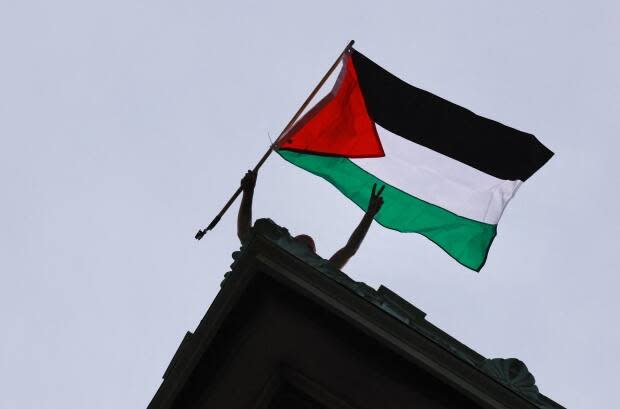
But for some, the red triangle is reminiscent of the classification used in the Holocaust to identify political prisoners in Nazi camps, Musu said.
As the Auschwitz-Birkenau memorial and museum explains, the camps identified prisoners using coloured triangles, including red for political prisoners and pink for gay prisoners.
Several posts online have noted the similarity, including an Instagram Reel by Jewish actor Amanda Markowitz, who wrote, "Either they truly don't know or they do know and are using Holocaust inversion … and both of these options are dangerous."

Use in campus encampments
Campus protests over the Israel-Hamas war have spread around the world in recent weeks, and many, including the encampment at the University of Toronto, have used the red triangle imagery.
Earlier in May, pro-Palestinian protesters at the University of Pennsylvania defaced a statue of Benjamin Franklin, drawing an inverted red triangle on its forehead, according to the Philadelphia Inquirer.
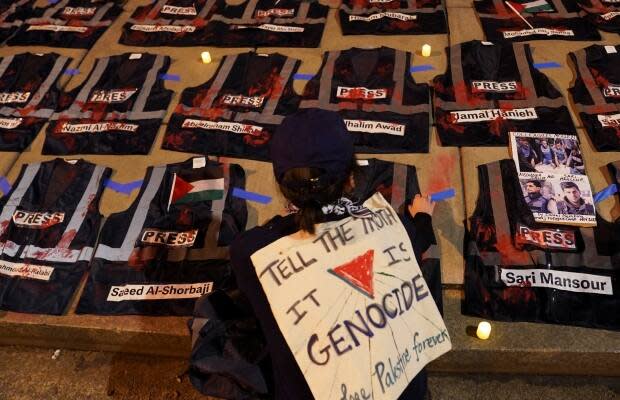
The paper reported that two small red triangles appeared on grey tape at the statue's base a few days later.
The symbol was also photographed Thursday on a pro-Palestinian protest sign at the Université du Québec à Montréal encampment.
The use of the triangle at U of T's encampment was referenced last week at a parliamentary committee by Conservative MP Melissa Lantsman. The presidents of four Canadian universities were defending their institutions' efforts to combat antisemitism on their campuses amid pro-Palestinian demonstrations.
"That's a symbol that glorifies terrorism by Hamas," Lantsman said at the meeting, holding up a photo of the symbol.
Sara Rasikh, a graduate student and spokesperson for the U of T encampment, told CBC News' social team the triangle is predominantly a symbol of resistance. She said she would ask anyone who feels uncomfortable by it to "look inward."
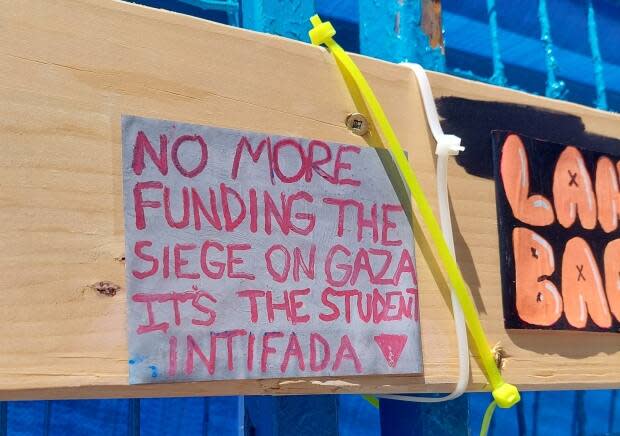
"There's a difference between feeling unsafe and and feeling uncomfortable. The people who are unsafe on this campus are Palestinians," said Rasikh.
"That being said, sure, there are multiple ... interpretations of it."
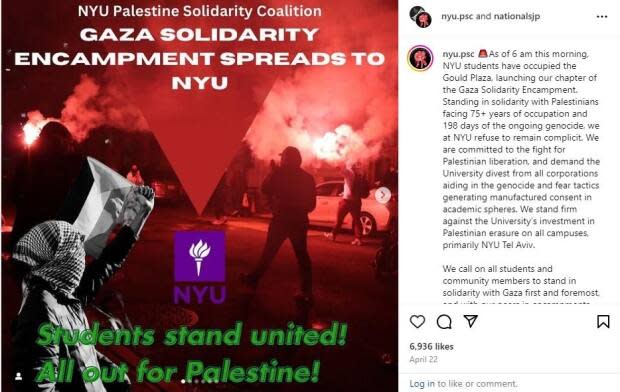
When questioned about it by the committee, U of T president Meric Gertler didn't comment on the triangle specifically. But the school has asked protest organizers to remove offensive symbols or signs, he said. Gertler also said the school in other instances has reported "hateful acts or hateful speech" to Toronto police.
Desai said politicians have misinterpreted the symbol to repress and criminalize pro-Palestinian protests.
"Politicians in this country, through racist rhetoric, dehistoricize and misconstrued many slogans, symbols and chants that have been linked to people's resistance against colonialism and imperialism historically and in the present."
A target, resistance, retaliation
The Anti-Defamation League says the inverted red triangle is now used to glorify violence by Hamas. The Middle East Monitor says its origins don't matter because symbols can take on a new meaning over time.
In the current war, experts have noted the triangle first appeared in Al-Qassam videos around November 2023. Red triangles can be seen identifying soldiers in a Hamas video posted to X on Nov. 4 by news outlet Al Jazeera Arabic.
For some, the triangle also symbolizes resistance to Israeli military occupation, Desai said, which she noted that Palestinians have a recognized right under international law to resist.
"For many — especially Palestinians, Arabs and racialized people — the red triangle may be used to affirm the resurgence of Palestinian calls for liberation."
As Al Jazeera pointed out, the red triangle also mimics the slingshot, a symbol of resistance in Gaza and the West Bank.
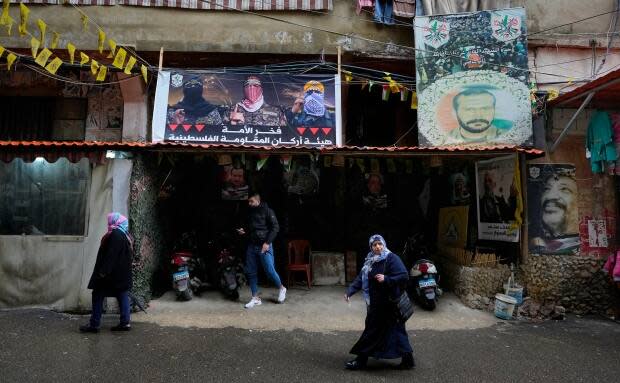
The Israel Defence Forces (IDF) has also reportedly used the symbol to mimic Hamas and retaliate against the group.
According to Al Jazeera, an IDF spokesperson released a video last year using red triangles to indicate Hamas targets, allegedly with a message at the end: "Our triangle is stronger than yours."
'Psychological propaganda,' or a symbol of a 'dream'
The triangle is sometimes also associated with a "bee sting" image in caricatures to mark casualties, antisemitism researcher Lev Topor wrote in the Times of Israel earlier this month.
He calls the use of the symbols "psychological propaganda" that dehumanize deaths.
Using the red triangles, he wrote, Hamas aims to instil fear in Israel's population and its armed forces, but also to get outside support using an "easy-to-understand sign" on the streets and on university campuses.
Red triangles now appear online and on merchandise such as T-shirts, he said.
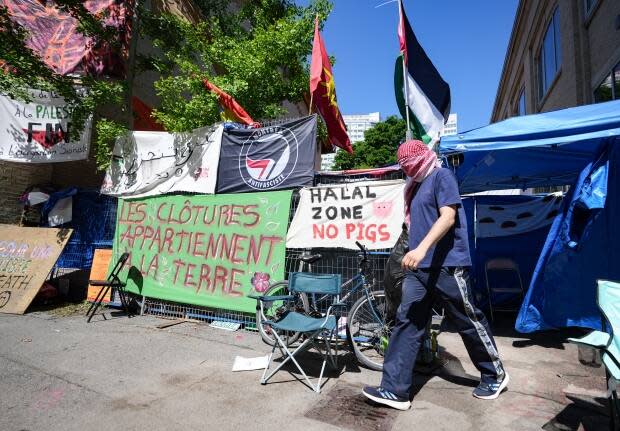
Since Oct. 7, the inverted red triangle has also popped up throughout the Burj al-Barajneh Palestinian refugee camp in Beirut, The Guardian reported last month.
There, the triangle — and the war itself — symbolizes the "dream to return to a homeland that has existed only in distant memories of an older generation," the article says.
Context matters
Sukarieh questioned why Lantsman, the Conservative MP, was so focused on the symbol instead of "what the ICJ [International Court of Justice] called a plausible genocide."
South Africa filed a case with the ICJ last year, accusing Israel of committing genocide during its military campaign in Gaza. In January, ICJ judges ordered Israel to do all it can to prevent death, destruction and any acts of genocide in the region.
On Friday, the ICJ also ruled that Israel must ensure access for any fact-finding or investigative mission sent by the UN to assess the genocide allegations.
Israel has called the allegations "false, outrageous and disgusting."
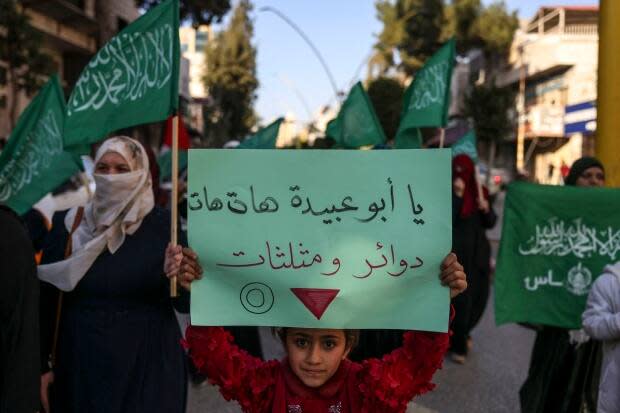
The inverted triangle refers to a target, Sukarieh said, and what people need to target are their governments.
"Not only for Palestine, but for the sake of our own democracies wherever we are, for our own freedom of speech, for our own universities."
Symbols can be interpreted differently, said Musu, at the University of Ottawa. But when coupled with protesters shouting antisemitic slogans, the meaning becomes questionable.
"The conversation sometimes seems to be not so much about the conflict, and stopping the conflict and stopping the suffering, but about doubting the legitimacy of the state of Israel to exist to begin with."
WATCH | How the watermelon became a symbol of resistance:


